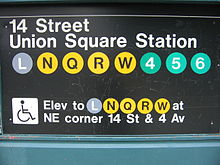It used to be that every house on the block offered candy to trick-or-treaters, but then allergies and health consciousness kicked in and the candy bars were no longer standard. I am all for offering a variety of Halloween treats to avoid overloading children with excess sugar, and for offering non-candy treats as an option. (See the dot from last year about the teal pumpkin project)
But Dole has taken the healthy-holiday idea too far by offering mini-salads as an option for those who come to your door. I doubt that most would see it as a trick instead of a treat!
What’s next? Pumpkin Spice Lettuce? There is a limit to how much nutrition you should promote on a holiday centered around sweetness.
Keep the context and your audience in mind when planning advertising or product launches. You don’t need to insert yourself into every holiday or fad.
Thanks, Meg!
Daily observations of how dots connect in life and in organizations
Tuesday, October 31, 2017
Monday, October 30, 2017
leadership dot #1977: discussion
A quote on the radio said: “arguments find out who is right; discussions find out what is right.” I like the distinction.
Too often, a conversation devolves into an argument and the focus changes from learning to winning. In a conversation, there is banter, but with civility and empathy; the focus remains on the content rather than the person.
The distinction reminded me of lessons from the book Creativity, Inc. by Ed Catmull. Ed is the co-founder of Pixar Animation Studios and president of Pixar Animation and Disney Animation. In his book, he describes “Dailies” where the animators show their in-process work to others each day in order to receive feedback on the details of their work. Ed writes: “By making the struggles to solve the problems safe to discuss, then everyone learns from – and inspires – one another. The whole activity becomes socially rewarding and productive. To participate fully each morning requires empathy, clarity, generosity and the ability to listen.”
Pixar has demonstrated how good discussions can work to make people more creative as they work together to improve the product. Keep your focus today on what is right, not who.
Radio source: Direct from Hollywood with Ryan Seacrest
Quote from Creativity, Inc. by Ed Catmull with Amy Wallace, 2014, p. 195.

Too often, a conversation devolves into an argument and the focus changes from learning to winning. In a conversation, there is banter, but with civility and empathy; the focus remains on the content rather than the person.
The distinction reminded me of lessons from the book Creativity, Inc. by Ed Catmull. Ed is the co-founder of Pixar Animation Studios and president of Pixar Animation and Disney Animation. In his book, he describes “Dailies” where the animators show their in-process work to others each day in order to receive feedback on the details of their work. Ed writes: “By making the struggles to solve the problems safe to discuss, then everyone learns from – and inspires – one another. The whole activity becomes socially rewarding and productive. To participate fully each morning requires empathy, clarity, generosity and the ability to listen.”
Pixar has demonstrated how good discussions can work to make people more creative as they work together to improve the product. Keep your focus today on what is right, not who.
Radio source: Direct from Hollywood with Ryan Seacrest
Quote from Creativity, Inc. by Ed Catmull with Amy Wallace, 2014, p. 195.

Sunday, October 29, 2017
leadership dot #1976: freaky
Most stores are decorating for Halloween using pumpkins or gourds, but one grocery store got creative with their display. Their produce department went all out to acquire some of the lesser-known fruits and present them in a “freaky fruits” display.
Ever heard of rambutan, red cactus pears, dragon fruit, kiwano melon or jackfruits? I had not, but their display made them look intriguing. The store also took care to give nutritional and taste information as well as instructions on how to eat them. It was an authentic link to their products and brand – as well as making for an eye-catching display.
We often default to the known and easy – like decorating for Fall with pumpkins – but how can you use the holidays as an opportunity for creativity and experimentation? Challenge yourself to add something new to your celebration mix – maybe even something from the produce department!





Ever heard of rambutan, red cactus pears, dragon fruit, kiwano melon or jackfruits? I had not, but their display made them look intriguing. The store also took care to give nutritional and taste information as well as instructions on how to eat them. It was an authentic link to their products and brand – as well as making for an eye-catching display.
We often default to the known and easy – like decorating for Fall with pumpkins – but how can you use the holidays as an opportunity for creativity and experimentation? Challenge yourself to add something new to your celebration mix – maybe even something from the produce department!





Saturday, October 28, 2017
leadership dot #1975: sweetener
One of the most delightful gifts I have received came via email last week when a friend sent me a Sugarwish. I had not heard of this before, but the giver pre-pays for a treat box for you, Sugarwish sends you an email, then the recipient has the envious/difficult task of picking out their treats from a selection of about 50 different types. Once you make the selection, it arrives via mail in a fancy package with a message card – and is so much fun!
Trying to pick out the candies was like a virtual trip to an old-fashioned candy store – many old brands like Mary Janes and Runts as well as some I had not heard of like grapefruit gummies. It was such a wonderful way to say “I Miss You!” across the miles.
We often think of others and intend to send them a greeting, but frequently it doesn’t get acted upon or ends up as a quick email or Facebook message. If you truly want to make an impression, think about virtual gifts like Sugarwish, Starbucks virtual e-gift cards or other ways to enhance your greeting or thank you. Sending along a treat that the recipient is sure to enjoy – and likely would never purchase for themselves – is a sure way to create a memorable sweet spot in your communication.

Trying to pick out the candies was like a virtual trip to an old-fashioned candy store – many old brands like Mary Janes and Runts as well as some I had not heard of like grapefruit gummies. It was such a wonderful way to say “I Miss You!” across the miles.
We often think of others and intend to send them a greeting, but frequently it doesn’t get acted upon or ends up as a quick email or Facebook message. If you truly want to make an impression, think about virtual gifts like Sugarwish, Starbucks virtual e-gift cards or other ways to enhance your greeting or thank you. Sending along a treat that the recipient is sure to enjoy – and likely would never purchase for themselves – is a sure way to create a memorable sweet spot in your communication.

Friday, October 27, 2017
leadership dot #1974: things I believe
In a fortuitous sequence of events, I watched a Pinkcast with Dan Pink and Bob Sutton that led me to an article Sutton wrote entitled “13 Things I Believe.” Sutton said that he used his list as an ending ritual in the organizational behavior class that he taught – and, since I am teaching that course this term, I decided to make my own list and do the same.
I, too, ended up with 13 things on my list, but more because that is all that nicely fit on one page than because of any definitive reason. I could have created many more words of wisdom I would like my students to know, but since my review of the list was all that was standing between them and freedom, I suspected that less would be more.
As with many things that come from being a teacher, I learned something from doing this exercise myself. I would recommend it to everyone as a way to pause for a few moments (see item #12!) and ponder what undergirds your behaviors and choices.
Here are the 13 Things I Believe, in a slightly different format than Sutton’s, but with the same reflective spirit nonetheless. I hope you enjoy them as much as my students seemed to have done.
I, too, ended up with 13 things on my list, but more because that is all that nicely fit on one page than because of any definitive reason. I could have created many more words of wisdom I would like my students to know, but since my review of the list was all that was standing between them and freedom, I suspected that less would be more.
As with many things that come from being a teacher, I learned something from doing this exercise myself. I would recommend it to everyone as a way to pause for a few moments (see item #12!) and ponder what undergirds your behaviors and choices.
Here are the 13 Things I Believe, in a slightly different format than Sutton’s, but with the same reflective spirit nonetheless. I hope you enjoy them as much as my students seemed to have done.
Thursday, October 26, 2017
leadership dot #1973: run
For some marathon runners, it’s all about their time, while other runners have a goal focused on completing the race. Either way, I think that most who sign up for such a strenuous run are expecting the route to be 26.1 miles.
This wasn’t the case at the PNC Milwaukee Marathon – and the route wasn’t off by a small amount, it was .8 miles or 4,224 feet shy of the standard distance. So the runners who thought they had a spectacular time, in reality, did not, and those who believe they qualified for the Boston Marathon did not do that either. The year before, someone set up the cones incorrectly making this same marathon too long by almost a mile. Yikes!
It would seem that for something as important as the route distance that someone would double check it after it had been set up. Both times, the error appears to have occurred in interpreting the route map, and especially after a debacle in 2016, you would think that having a correct distance would have been Job #1 for this year’s marathon.
I am sure that hosting a 26-mile race for 785 runners is a logistical challenge, just as your organization faces many complex issues to resolve. But take a lesson from Milwaukee and don’t get so caught up in the minor details that you fail to deliver the core element of your experience. Measure your route. Twice.
Source: Runners react to PNC Milwaukee Marathon distance blunder; Boston Marathon won’t accept times by Lori Nickel in the Milwaukee Journal Sentinel online, October 19, 2017.
Thanks, Meg!
This wasn’t the case at the PNC Milwaukee Marathon – and the route wasn’t off by a small amount, it was .8 miles or 4,224 feet shy of the standard distance. So the runners who thought they had a spectacular time, in reality, did not, and those who believe they qualified for the Boston Marathon did not do that either. The year before, someone set up the cones incorrectly making this same marathon too long by almost a mile. Yikes!
It would seem that for something as important as the route distance that someone would double check it after it had been set up. Both times, the error appears to have occurred in interpreting the route map, and especially after a debacle in 2016, you would think that having a correct distance would have been Job #1 for this year’s marathon.
I am sure that hosting a 26-mile race for 785 runners is a logistical challenge, just as your organization faces many complex issues to resolve. But take a lesson from Milwaukee and don’t get so caught up in the minor details that you fail to deliver the core element of your experience. Measure your route. Twice.
Source: Runners react to PNC Milwaukee Marathon distance blunder; Boston Marathon won’t accept times by Lori Nickel in the Milwaukee Journal Sentinel online, October 19, 2017.
Thanks, Meg!
Wednesday, October 25, 2017
leadership dot #1972: circles
When you advance in an organization and gain additional responsibilities, often the scope of your job increases as well. You’re in for a tough time if you continually try to act in the same way instead of changing your behavior to reflect your expanded scope.
Think of your responsibilities as concentric circles. As your breadth increases, it behooves you to interact with those in the further circles differently than you did when you were closer to them, now often learning about them through those in circles closer to you.
A head banker may work through tellers or tellers’ supervisors to hear client feedback instead of receiving it directly as she did when she worked behind a counter in the branch, and instead spend more time with other department heads. A restaurant manager may work through shift leaders instead of spending time with individual employees so that he can devote more time to learning from peers or other franchisees.
I was coaching someone who works on a campus and was lamenting how the additional responsibilities took her further away from direct student contact. But the new role shifted her “circles” and made working with those above her demand more time and attention. She could work 14-hour days trying to do it all, or she could interact with the students through her direct reports instead.
As you rise to the top and have a broader scope, by necessity, the circles with whom you interact/influence naturally change. I encourage you to identify who occupies priority ranking in your circles (for example: boss = #1, peers = #2, direct reports = #3, other colleagues = #4, indirect reports = #5, etc.) and then consider the time you allocate to each. It may help you to loosely plot out a week’s time by circle — does it achieve the distribution (not balance) that you want?
Don’t spread yourself too thin and shortchange your inner circle by trying to do too much with your outer circle (even if they are more fun!)
Think of your responsibilities as concentric circles. As your breadth increases, it behooves you to interact with those in the further circles differently than you did when you were closer to them, now often learning about them through those in circles closer to you.
A head banker may work through tellers or tellers’ supervisors to hear client feedback instead of receiving it directly as she did when she worked behind a counter in the branch, and instead spend more time with other department heads. A restaurant manager may work through shift leaders instead of spending time with individual employees so that he can devote more time to learning from peers or other franchisees.
I was coaching someone who works on a campus and was lamenting how the additional responsibilities took her further away from direct student contact. But the new role shifted her “circles” and made working with those above her demand more time and attention. She could work 14-hour days trying to do it all, or she could interact with the students through her direct reports instead.
As you rise to the top and have a broader scope, by necessity, the circles with whom you interact/influence naturally change. I encourage you to identify who occupies priority ranking in your circles (for example: boss = #1, peers = #2, direct reports = #3, other colleagues = #4, indirect reports = #5, etc.) and then consider the time you allocate to each. It may help you to loosely plot out a week’s time by circle — does it achieve the distribution (not balance) that you want?
Don’t spread yourself too thin and shortchange your inner circle by trying to do too much with your outer circle (even if they are more fun!)
Tuesday, October 24, 2017
leadership dot #1971: respect
I stopped at the Dollar Tree on my way to teach an organizational behavior class and I couldn’t believe the irony of what I saw. There, posted on the outer window of the office, in plain view for all the customers, was a handwritten sign that said: “Respect + Listen to your Managers!! Give Respect! Get Respect!”

This was bad enough, but right next to it was a sign that promoted open interviews/now hiring! I laughed out loud.
Who would want to work at a place like this? And how can the managers possibly believe that such a sign is going to do anything to help an already aggravated situation?
The sign implies that employees and managers can hand out respect like trick-or-treat candy. If only it were that simple. Respect is earned, not given. Respect takes time and repeated actions to build a foundation of trust from which respect can grow. Respect is humble and does not require handwritten signs with underlines and exclamation points.
If you are wanting your employees to “Give Respect!” YOU as the manager need to be the one to earn it first. Maybe their “open interviews” should be to hire someone else to lead the store!

This was bad enough, but right next to it was a sign that promoted open interviews/now hiring! I laughed out loud.
Who would want to work at a place like this? And how can the managers possibly believe that such a sign is going to do anything to help an already aggravated situation?
The sign implies that employees and managers can hand out respect like trick-or-treat candy. If only it were that simple. Respect is earned, not given. Respect takes time and repeated actions to build a foundation of trust from which respect can grow. Respect is humble and does not require handwritten signs with underlines and exclamation points.
If you are wanting your employees to “Give Respect!” YOU as the manager need to be the one to earn it first. Maybe their “open interviews” should be to hire someone else to lead the store!
Monday, October 23, 2017
leadership dot #1970: strengths
I read with interest an article about feral cats that are unadoptable, but become valuable as they help companies keep their mice away.
In Philadelphia, the animal shelter works with businesses to place cats that bite, scratch or are generally unsocial into barns, breweries, stables and factories. The cats are well cared for and perform a valuable service doing what they instinctively do. Everyone is happy!
This is an ingenious idea. It acknowledges the reality that the cats are not going to be adopted, but prevents them from being killed. The companies receive a necessary service for a low cost and it reduces expenses at the shelter instead of caring for the cats indefinitely.
The shelters capitalized on a disadvantage by taking advantage of the strength that accompanied it, thus rude cats + natural hunters = mousers in warehouses. How can you do the same? I have heard of people who have lost their sense of smell being paid large sums to do jobs that would repulse the olfactory-able. Those confined to a wheelchair could be placed in a job that requires long periods of sitting. Those who are blind could make better taste-testers as they are not influenced by packaging or appearance.
Strengths theory would say that you should focus on your strengths instead of your weaknesses. Take a lesson from the working cat program and redefine what strengths you truly have.
Source: Ornery cats get 2nd chance with jobs chasing mice by Kristen DeGroot for The Associated Press in the Telegraph Herald, October 22, 2017, p. 11A
In Philadelphia, the animal shelter works with businesses to place cats that bite, scratch or are generally unsocial into barns, breweries, stables and factories. The cats are well cared for and perform a valuable service doing what they instinctively do. Everyone is happy!
This is an ingenious idea. It acknowledges the reality that the cats are not going to be adopted, but prevents them from being killed. The companies receive a necessary service for a low cost and it reduces expenses at the shelter instead of caring for the cats indefinitely.
The shelters capitalized on a disadvantage by taking advantage of the strength that accompanied it, thus rude cats + natural hunters = mousers in warehouses. How can you do the same? I have heard of people who have lost their sense of smell being paid large sums to do jobs that would repulse the olfactory-able. Those confined to a wheelchair could be placed in a job that requires long periods of sitting. Those who are blind could make better taste-testers as they are not influenced by packaging or appearance.
Strengths theory would say that you should focus on your strengths instead of your weaknesses. Take a lesson from the working cat program and redefine what strengths you truly have.
Source: Ornery cats get 2nd chance with jobs chasing mice by Kristen DeGroot for The Associated Press in the Telegraph Herald, October 22, 2017, p. 11A
Sunday, October 22, 2017
leadership dot #1969: strip
While out walking, I came upon a strip mall with four businesses and the odd juxtaposition of the four seemed to represent mindsets that people adopt about the future.
The strip mall housed:
> Suntan City – with a focus on short-term gain without consideration to long-term impact
> Mississippi Valley Blood Center – where people realize short-term gain ($) but also provide long-term impact (to others)
Think about which one is a metaphor for how you deal with the future. Maybe it’s time for you to check out another business on the strip.

The strip mall housed:
> Suntan City – with a focus on short-term gain without consideration to long-term impact
> Mississippi Valley Blood Center – where people realize short-term gain ($) but also provide long-term impact (to others)
> State Farm Insurance – for those
with pessimism about the future who want to hedge their bets, spending
thousands on something they hope they never need
> Edward Jones Investments – for those with
optimism about the future, making them willing to risk to hopefully realize
long-term gain
Think about which one is a metaphor for how you deal with the future. Maybe it’s time for you to check out another business on the strip.

Saturday, October 21, 2017
leadership dot #1968: standard
I am a typography nerd, so when I discovered the link to the New York City Transit Authority Graphics Standards Manual, I reveled in the opportunity to see some of the iconic pages online (it is also now a book). The signage standards were first designed in 1970, and the strict adherence to them has made them one of NYC’s most famous landmarks.
Determining a font style, kerning and color palette does not seem like sexy work, but it is through the consistency of application that the subway signs have become art. There is no variance is what is acceptable and this repetition makes them memorable.
Those who write standards manuals and enforce the application of them are often seen as nitpickers. I remember supporting the graphic designer who reprinted an entire order of notecards because the color was slightly off. Others wanted to keep them and “use them internally” but we recycled the whole lot. I am sure the NYC subway folks would have done the same.
There is a dual meaning to “standard” – and creating a standards manual that you strictly follow will make your work a gold standard for others to follow.
Determining a font style, kerning and color palette does not seem like sexy work, but it is through the consistency of application that the subway signs have become art. There is no variance is what is acceptable and this repetition makes them memorable.
Those who write standards manuals and enforce the application of them are often seen as nitpickers. I remember supporting the graphic designer who reprinted an entire order of notecards because the color was slightly off. Others wanted to keep them and “use them internally” but we recycled the whole lot. I am sure the NYC subway folks would have done the same.
There is a dual meaning to “standard” – and creating a standards manual that you strictly follow will make your work a gold standard for others to follow.
 |
| http:standardsmanual.com |
Friday, October 20, 2017
leadership dot #1967: tendencies
Socrates said: “To know thyself is the beginning of wisdom” and even though the advice is two thousand years old, it is still valid; self-knowledge is one of the most powerful tools that you can have in your career arsenal.
I have always been fascinated with personality assessments and tools that help you gain insight into your personal preferences or styles. I look at them as mirrors, bringing into resolution an aspect of myself that I otherwise would not see. The assessments also provide me with language to describe feelings or behaviors that are so ingrained that I take for granted that everyone possesses them.
One of the newest insights has occurred through Gretchen Rubin’s Four Tendencies Quiz. The results describe how you respond to inner expectations we set for ourselves and outer expectations that others impose. Rubin outlines four frameworks for the Tendencies: Upholder (who meets both inner and outer expectations), Rebel (who resists both), Questioner (resists outer but meets inner) and Obliger (meets outer but resists inner).
You can take the free quiz here.
Having additional knowledge about yourself can help you design strategies to compensate in areas where you are challenged and to set up systems that play to your strengths. Knowing such information about your staff can also help you tailor your supervisory style to align with others’ tendencies and help everyone achieve success.
Spend a few minutes today heeding Socrates’ advice and gain some wisdom that will help change your habits.
I have always been fascinated with personality assessments and tools that help you gain insight into your personal preferences or styles. I look at them as mirrors, bringing into resolution an aspect of myself that I otherwise would not see. The assessments also provide me with language to describe feelings or behaviors that are so ingrained that I take for granted that everyone possesses them.
One of the newest insights has occurred through Gretchen Rubin’s Four Tendencies Quiz. The results describe how you respond to inner expectations we set for ourselves and outer expectations that others impose. Rubin outlines four frameworks for the Tendencies: Upholder (who meets both inner and outer expectations), Rebel (who resists both), Questioner (resists outer but meets inner) and Obliger (meets outer but resists inner).
You can take the free quiz here.
Having additional knowledge about yourself can help you design strategies to compensate in areas where you are challenged and to set up systems that play to your strengths. Knowing such information about your staff can also help you tailor your supervisory style to align with others’ tendencies and help everyone achieve success.
Spend a few minutes today heeding Socrates’ advice and gain some wisdom that will help change your habits.
Thursday, October 19, 2017
leadership dot #1966: check out
The Delta Airlines app on my phone recently did an update and I was delighted to learn that they have eliminated the check-in process. Boarding passes will now automatically populate 24 hours before a flight, saving thousands of passengers from tracking down a computer and verifying that they will, in fact, use the non-refundable seat that they have paid hundreds of dollars to buy.
I suspect that airline check-ins have been a staple of the process since commercial flight began. I also imagine that many of those who have a seat that they don’t use still have checked in for the flight: an emergency came up at the last minute, their incoming flight was late so they missed the connection, they were held up en route or at TSA, etc.
I applaud the person who had the wisdom to question this long-standing practice and ask if the value outweighed the inconvenience to passengers. It was something that was taken for granted as part of the process that did not need to remain.
Maybe it is time for you to step back and evaluate the processes that have not been questioned for years. Tom Wujec’s How to Draw Toast may help you structure this exercise. What do you require of your clients that has outlived its usefulness: filling out forms instead of updating them to register each year? Requiring clients to show the same insurance card for each visit? Printing out pages of medication instructions for renewals?
If Delta can fly without manual check-ins, what can you do to travel lighter with your processes?
I suspect that airline check-ins have been a staple of the process since commercial flight began. I also imagine that many of those who have a seat that they don’t use still have checked in for the flight: an emergency came up at the last minute, their incoming flight was late so they missed the connection, they were held up en route or at TSA, etc.
I applaud the person who had the wisdom to question this long-standing practice and ask if the value outweighed the inconvenience to passengers. It was something that was taken for granted as part of the process that did not need to remain.
Maybe it is time for you to step back and evaluate the processes that have not been questioned for years. Tom Wujec’s How to Draw Toast may help you structure this exercise. What do you require of your clients that has outlived its usefulness: filling out forms instead of updating them to register each year? Requiring clients to show the same insurance card for each visit? Printing out pages of medication instructions for renewals?
If Delta can fly without manual check-ins, what can you do to travel lighter with your processes?
Wednesday, October 18, 2017
leadership dot #1965: Gen X
Generation X – those born between 1965-1979 are the middle child of current generational studies. Baby Boomers (1946-1964) are seen as passé and all the attention is on Millennials (1980-1994) or Generation Z (1995-present) instead of Gen X even though they represent over 20% of the workforce.
Generation Xers are predominately people in their 40s and were heavily influenced by the social changes that occurred during their childhood. Gen X is the first generation that grew up with technology, one of the factors that make them fans of multi-tasking.
When I first started presenting about Gen X coming to college, they were known as the “baby busters.” While I was aware that, compared to the Baby Boomers, historians labeled them as much more self-oriented and materialistic, what I saw as their key distinguishing trait was the element of choice. Gen Xers had a choice in far more categories than any generation before them: no longer were Prell and Breck the only shampoos, pink and red the only nail colors and one license plate design issued per state. Gen X had aisles full of toothpaste brands, thousands of credit card options and a proliferation of media content.
And with this choice came the desire to have it “my way,” a characteristic that earned them their negative connotations. Gen X was the first generation to be lavished with recognition and praise (making them cynical), and also the first group who wanted to postpone commitment (why decide when there are so many choices and something better may come along?!). This was the first group that grew up with both parents working, making them more independent and interested in autonomy.
Generation Xers hold many of the up-and-coming leadership roles in our organizations and society. Keep their perspective in mind if you are working with or for someone in the 38-52 age range. Provide options, independence, lots of information in little bite-sized pieces, clear procedures and praise!
Generation Xers are predominately people in their 40s and were heavily influenced by the social changes that occurred during their childhood. Gen X is the first generation that grew up with technology, one of the factors that make them fans of multi-tasking.
When I first started presenting about Gen X coming to college, they were known as the “baby busters.” While I was aware that, compared to the Baby Boomers, historians labeled them as much more self-oriented and materialistic, what I saw as their key distinguishing trait was the element of choice. Gen Xers had a choice in far more categories than any generation before them: no longer were Prell and Breck the only shampoos, pink and red the only nail colors and one license plate design issued per state. Gen X had aisles full of toothpaste brands, thousands of credit card options and a proliferation of media content.
And with this choice came the desire to have it “my way,” a characteristic that earned them their negative connotations. Gen X was the first generation to be lavished with recognition and praise (making them cynical), and also the first group who wanted to postpone commitment (why decide when there are so many choices and something better may come along?!). This was the first group that grew up with both parents working, making them more independent and interested in autonomy.
Generation Xers hold many of the up-and-coming leadership roles in our organizations and society. Keep their perspective in mind if you are working with or for someone in the 38-52 age range. Provide options, independence, lots of information in little bite-sized pieces, clear procedures and praise!
Tuesday, October 17, 2017
leadership dot #1964: easier
A reader with a past gambling history wrote to syndicated columnist Jerry Romansky asking how to handle a night at the casino that other couples planned for the group during their vacation. His advice: “Prevention is easier than correction.”
How true it is, and not just for gambling, but for dozens of other applications:
> Maintaining a grasp on your email volume is easier when done daily rather than when your storage is full.
> Nipping a performance issue in the bud is certainly more effective than discipline down the line.
> Keeping up with preventative maintenance on your car and home is far easier than dealing with repairs.
> Tending to relationships and preventing issues from festering leads to greater satisfaction vs. counseling or shouting.
> Limiting your opponent to small gains and maintaining your lead sure beats playing catch up.
> Keeping your body at an appropriate weight is easier than trying to lose weight after gaining it.
> Spending within your means involves fewer sacrifices than trying to get out of debt.
The time and energy you spend correcting a problem are usually greater than the efforts you would have invested to avoid it. Make the hard choices in the beginning and keep your focus on the prevention side of the equation.
Source: Ask Jerry column by Jerry Romansky in the Telegraph Herald, October 15, 2017, p. 2C
How true it is, and not just for gambling, but for dozens of other applications:
> Maintaining a grasp on your email volume is easier when done daily rather than when your storage is full.
> Nipping a performance issue in the bud is certainly more effective than discipline down the line.
> Keeping up with preventative maintenance on your car and home is far easier than dealing with repairs.
> Tending to relationships and preventing issues from festering leads to greater satisfaction vs. counseling or shouting.
> Limiting your opponent to small gains and maintaining your lead sure beats playing catch up.
> Keeping your body at an appropriate weight is easier than trying to lose weight after gaining it.
> Spending within your means involves fewer sacrifices than trying to get out of debt.
The time and energy you spend correcting a problem are usually greater than the efforts you would have invested to avoid it. Make the hard choices in the beginning and keep your focus on the prevention side of the equation.
Source: Ask Jerry column by Jerry Romansky in the Telegraph Herald, October 15, 2017, p. 2C
Monday, October 16, 2017
leadership dot #1963: radical candor
As we commemorate Bosses Day today, I remind all bosses and aspiring bosses that one of their most important functions is to provide feedback to employees. One model that helps to frame the spectrum of feedback options was developed by Kim Scott, author of the 2017 book Radical Candor.
Kim’s premise is that for effective feedback, the person must Care Personally and Challenge Directly. If someone has accomplished both aspects, she terms their feedback as Radical Candor – where you can provide direct and helpful feedback to help the person grow.

People often Care Personally – a lot – and because of their focus on being nice, they fail to challenge directly. Kim believes this is Ruinous Empathy, luring the person into a false sense of security because they have not received the honest feedback they deserve.
The opposite extreme is Obnoxious Aggression – feedback that is given without care and thus is often ignored or seen as not helpful.
On her website (radicalcandor.com), Kim shares stories and provides many more examples of the quadrants in action, but I believe this simple diagram will provide you with some fodder to consider today.
Where do you fall on the Care Personally/Challenge Directly spectrum? Have you truly shown your employees (or colleagues, partner, children, etc.) that you care about them? Do you care enough to provide the honest feedback that they would benefit from hearing or do you avoid it to keep yourself comfortable?
We'd all be better off if we delivered feedback with Radical Candor, keeping the civility and care as part of the equation while still saying what needs to be said.
Radical Candor handout
Thanks to Meghan for connecting me with this resource!
Kim’s premise is that for effective feedback, the person must Care Personally and Challenge Directly. If someone has accomplished both aspects, she terms their feedback as Radical Candor – where you can provide direct and helpful feedback to help the person grow.

People often Care Personally – a lot – and because of their focus on being nice, they fail to challenge directly. Kim believes this is Ruinous Empathy, luring the person into a false sense of security because they have not received the honest feedback they deserve.
The opposite extreme is Obnoxious Aggression – feedback that is given without care and thus is often ignored or seen as not helpful.
On her website (radicalcandor.com), Kim shares stories and provides many more examples of the quadrants in action, but I believe this simple diagram will provide you with some fodder to consider today.
Where do you fall on the Care Personally/Challenge Directly spectrum? Have you truly shown your employees (or colleagues, partner, children, etc.) that you care about them? Do you care enough to provide the honest feedback that they would benefit from hearing or do you avoid it to keep yourself comfortable?
We'd all be better off if we delivered feedback with Radical Candor, keeping the civility and care as part of the equation while still saying what needs to be said.
Radical Candor handout
Thanks to Meghan for connecting me with this resource!
Sunday, October 15, 2017
leadership dot #1962: hello science
There have been many efforts to promote science and STEM education with girls, but I think that the target audience will hear the message more loudly thanks to a new partnership with Hello Kitty. The internationally famous icon has come out with a new line of products promoting science, and especially science for girls.
Hello Kitty has previously attached its brand to cosmetic lines and frilly pink items so it is delightful to see it expanding its influence in ways that could encourage young girls to explore new career areas. Even if Hello Kitty fans don’t go into science directly, prompting them to “think like a scientist” will pay dividends in all aspects of life.
Hello Kitty + science is outside their norm, but smart. How can you think beyond the obvious to identify a new spokesperson for your brand and partner with someone that makes your message purr?
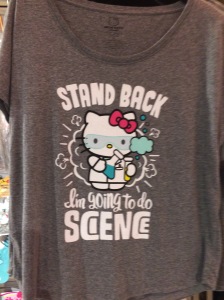
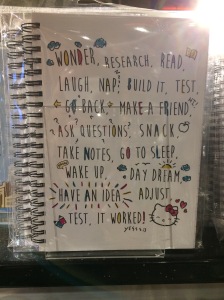
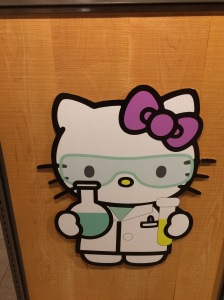
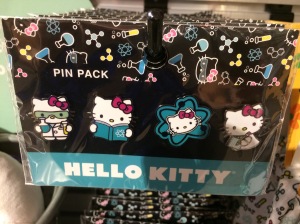
Hello Kitty has previously attached its brand to cosmetic lines and frilly pink items so it is delightful to see it expanding its influence in ways that could encourage young girls to explore new career areas. Even if Hello Kitty fans don’t go into science directly, prompting them to “think like a scientist” will pay dividends in all aspects of life.
Hello Kitty + science is outside their norm, but smart. How can you think beyond the obvious to identify a new spokesperson for your brand and partner with someone that makes your message purr?




Saturday, October 14, 2017
leadership dot #1961: souvenir
How many times has the airport been the only place you have seen in a city? Unfortunately, for frequent travelers, it happens regularly.
Kansas City (KCI) is catering to the airport crowd by offering a vending machine that allows travelers to bring home a souvenir of a higher caliber than the typical tchotchkes sold in airport stores. Even if you never get beyond the concourse, you can purchase desirable items from their clever SouveNEAR machine. It’s like an automated Etsy store, featuring cards, shirts, journals, snacks and jewelry – but all are handmade items that are produced locally.
KCI airport has done a great job of bringing their product to potential customers. Think of how you can take advantage of the ever-expanding capabilities of vending machines to reach your clientele. Spirit wear at athletic venues? Branded merchandise for your organization at your office or events? Convention centers that rotate merchandise depending on the current show? Rain gear at outdoor public places like zoos or amusement parks? A way to sell products of students or employees?
Dorothy and Toto may not be in Kansas anymore, but the effective use of vending machines certainly is. Click your Ruby Slippers and add vending to your brand outreach.
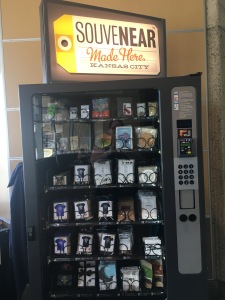

Kansas City (KCI) is catering to the airport crowd by offering a vending machine that allows travelers to bring home a souvenir of a higher caliber than the typical tchotchkes sold in airport stores. Even if you never get beyond the concourse, you can purchase desirable items from their clever SouveNEAR machine. It’s like an automated Etsy store, featuring cards, shirts, journals, snacks and jewelry – but all are handmade items that are produced locally.
KCI airport has done a great job of bringing their product to potential customers. Think of how you can take advantage of the ever-expanding capabilities of vending machines to reach your clientele. Spirit wear at athletic venues? Branded merchandise for your organization at your office or events? Convention centers that rotate merchandise depending on the current show? Rain gear at outdoor public places like zoos or amusement parks? A way to sell products of students or employees?
Dorothy and Toto may not be in Kansas anymore, but the effective use of vending machines certainly is. Click your Ruby Slippers and add vending to your brand outreach.


Friday, October 13, 2017
leadership dot #1960: looking for
When you are asked to recommend something – such as a book, a restaurant or an activity – it is tempting to jump in and answer with your favorite item in that category, but that is the wrong approach.
A concierge taught me that the correct answer to such questions is: “What are you looking for?” It is simple, yet brilliant.
> If you ask: “What are you looking for?” you can learn that a person wants either a quick bite to eat or a fancy meal – so your initial thought to recommend your favorite moderate restaurant is not appropriate for either.
> Knowing that someone wants a light romance novel or a romantic comedy movie shifts you away from suggesting the 800-page Hamilton book or Hacksaw Ridge movie even though both were excellent.
> If you learn that someone wants a stylist that is quick or inexpensive, it guides your answer to become much more helpful than giving the name of a professional who is costly and meticulously slow.
Whether providing recommendations for a realtor, candidate, store, contractor or neighborhood, the answer depends significantly on what the questioner is seeking.
No matter on what topic your advice is being solicited, one simple question can provide the clarification that makes your response both relevant and responsive. To provide the best service, reply to the next query with a question instead of an answer.
A concierge taught me that the correct answer to such questions is: “What are you looking for?” It is simple, yet brilliant.
> If you ask: “What are you looking for?” you can learn that a person wants either a quick bite to eat or a fancy meal – so your initial thought to recommend your favorite moderate restaurant is not appropriate for either.
> Knowing that someone wants a light romance novel or a romantic comedy movie shifts you away from suggesting the 800-page Hamilton book or Hacksaw Ridge movie even though both were excellent.
> If you learn that someone wants a stylist that is quick or inexpensive, it guides your answer to become much more helpful than giving the name of a professional who is costly and meticulously slow.
Whether providing recommendations for a realtor, candidate, store, contractor or neighborhood, the answer depends significantly on what the questioner is seeking.
No matter on what topic your advice is being solicited, one simple question can provide the clarification that makes your response both relevant and responsive. To provide the best service, reply to the next query with a question instead of an answer.
Thursday, October 12, 2017
leadership dot #1959: cleaning
Chihuly glass sculptures make for great art and are a visual treat for the observers, but what about the person who has to clean them? This article describes the work of glass cleaner Dave Pugh, who meticulously and cautiously takes individual pieces off the stainless steel studs, labels them, wraps them, cleans them and returns them to their original position. It is work behind-the-scenes that few consider, but is essential to the on-going enjoyment of the sculptures.
It reminded me of a photograph of the National Park Service workers who are charged with maintaining the Lincoln Memorial in Washington, DC. Twice a year they do their work in the middle of the night, cleaning areas that would entropy without attention. Cleaning the monument involves power washing, steam-cleaning, dusting and hand-finishing of the marble and takes a crew seven hours to complete.

Photo by Terry Adams,
National Park Service
None of the back-of-the-house jobs are glamorous, but all of them are essential. It is work that makes the front-facing elements more enjoyable and maintains the quality instead of allowing it to diminish over time.
Think about what is in your organization that should be on an annual or semi-annual cleaning schedule. Is there an exhibit that is starting to look tired or displays that could benefit from a sprucing up? Do you have furniture that is used daily in your waiting room, but no one can remember when the upholstery was last washed? Have you left all of your outside cleaning to Mother Nature instead of tending to your windows, signs and bricks?
Physical assets may be low maintenance, but nothing is no maintenance. Include some elbow grease time on your annual planning calendar to keep the sparkle in your possessions.
It reminded me of a photograph of the National Park Service workers who are charged with maintaining the Lincoln Memorial in Washington, DC. Twice a year they do their work in the middle of the night, cleaning areas that would entropy without attention. Cleaning the monument involves power washing, steam-cleaning, dusting and hand-finishing of the marble and takes a crew seven hours to complete.

Photo by Terry Adams,
National Park Service
None of the back-of-the-house jobs are glamorous, but all of them are essential. It is work that makes the front-facing elements more enjoyable and maintains the quality instead of allowing it to diminish over time.
Think about what is in your organization that should be on an annual or semi-annual cleaning schedule. Is there an exhibit that is starting to look tired or displays that could benefit from a sprucing up? Do you have furniture that is used daily in your waiting room, but no one can remember when the upholstery was last washed? Have you left all of your outside cleaning to Mother Nature instead of tending to your windows, signs and bricks?
Physical assets may be low maintenance, but nothing is no maintenance. Include some elbow grease time on your annual planning calendar to keep the sparkle in your possessions.
Wednesday, October 11, 2017
leadership dot #1958: compilation
If you have ever seen a Dale Chihuly sculpture, you know that they are a montage of intertwined glass in vibrant colors, with different shapes and colors assembled in unique and visually captivating forms.
Chihuly's work reminds me of yesterday’s dot, about how the Smithsonian curated a collection of John F. Kennedy photographs purchased from eBay. The exhibit exclusively utilized ordinary artifacts and made them special by their compilation. In a similar way, Chihuly utilizes individual pieces of glass that are not spectacular by themselves, but create stunning works of arts through their arrangement.
I think that too often we believe that greatness or creativity must be ONE.BIG.THING. -- a monumental discovery, an epic piece of art or a product that is truly magnificent. What Chihuly and the Smithsonian demonstrate is that little things can add up to create something with synergy greater than the individual pieces. Dots that are connected can result in something amazing and new, even though the components are not so special if considered alone.
Don’t let your fear of the mountain prevent you from taking that first step. Start from where you are, with what you have, and see if you don’t end up with something noteworthy by putting together the ordinary in new ways.


Chihuly Sanctuary at the Buffet Cancer Center, Omaha
Chihuly's work reminds me of yesterday’s dot, about how the Smithsonian curated a collection of John F. Kennedy photographs purchased from eBay. The exhibit exclusively utilized ordinary artifacts and made them special by their compilation. In a similar way, Chihuly utilizes individual pieces of glass that are not spectacular by themselves, but create stunning works of arts through their arrangement.
I think that too often we believe that greatness or creativity must be ONE.BIG.THING. -- a monumental discovery, an epic piece of art or a product that is truly magnificent. What Chihuly and the Smithsonian demonstrate is that little things can add up to create something with synergy greater than the individual pieces. Dots that are connected can result in something amazing and new, even though the components are not so special if considered alone.
Don’t let your fear of the mountain prevent you from taking that first step. Start from where you are, with what you have, and see if you don’t end up with something noteworthy by putting together the ordinary in new ways.


Chihuly Sanctuary at the Buffet Cancer Center, Omaha
Tuesday, October 10, 2017
leadership dot #1957: curate
A new exhibit at the Smithsonian features 77 photographs of President John F. Kennedy – nothing extraordinary there, except that all of them were purchased on eBay.
I imagine the Smithsonian as an elite institution with access to behind-the-scenes, never-before-seen artifacts (which I am sure is true), but for this exhibit, they chose to display only materials previously seen by thousands. And, again by choice, the materials were exhibited in their original form – without enlargements or enhancements for the display.
What struck me about this is that everyone had access to this Smithsonian-quality exhibit. You could have curated the exact same thing in your home or office. The magic is not in the items themselves, rather in the compilation of them.
What items can you assemble en masse to create a story of your own? Maybe it involves a wall of photographs, a collection of magazine covers or record albums, historical documents from your organization or ticket stubs from the events you have sponsored.
Whether from your archives or via eBay, your story is waiting to be told. Be resourceful like the Smithsonian and gather the visuals you need to tell it.
Source: Smithsonian displays JFK photos by Alex Gangitano for the Tribune News Service, in the Telegraph Herald, May 14, 2017, p. 5C.
I imagine the Smithsonian as an elite institution with access to behind-the-scenes, never-before-seen artifacts (which I am sure is true), but for this exhibit, they chose to display only materials previously seen by thousands. And, again by choice, the materials were exhibited in their original form – without enlargements or enhancements for the display.
What struck me about this is that everyone had access to this Smithsonian-quality exhibit. You could have curated the exact same thing in your home or office. The magic is not in the items themselves, rather in the compilation of them.
What items can you assemble en masse to create a story of your own? Maybe it involves a wall of photographs, a collection of magazine covers or record albums, historical documents from your organization or ticket stubs from the events you have sponsored.
Whether from your archives or via eBay, your story is waiting to be told. Be resourceful like the Smithsonian and gather the visuals you need to tell it.
Source: Smithsonian displays JFK photos by Alex Gangitano for the Tribune News Service, in the Telegraph Herald, May 14, 2017, p. 5C.
Monday, October 9, 2017
leadership dot #1956: team building
I continue to be astonished at how many
organizations leave some of their most important people to fend for themselves
and leave critical relationships to chance.
In organization after organization, I see people
promoted to a supervisory role with little to no training on how to be
effective in that drastically new position. Managers assume that if they had a
star employee doing X that the person will remain a star when now supervising
those who do X, even though the two skill sets are vastly different.
I also see too many organizations that believe
because a group of people has a common function that they automatically become
a team. Putting a group of people together under a heading on the
organizational chart does nothing to take into account the dynamics of that
relationship, the trust required to form a solid foundation or the challenges
in communication that arise when multiple people are involved. Yet the
organization offers little in terms of formal team building experiences or aid
to the leader on how to create a cohesive unit.
This does not need to happen! There are many
excellent resources and opportunities if only the organization wished to be
intentional about building capacity in its key staff.
Don’t assume strong supervision or effective team
development will happen on its own. Proactively investing in those who lead
others permeates many levels and provides value throughout the whole
organization.
Sunday, October 8, 2017
leadership dot #1955: dispense
You have seen public art, but the Prudential Mall in Boston has a new take on making culture accessible to the masses. The concourse features a Short Story Dispenser where you can select a reading time (1, 3 or 5 minutes) and the machine produces a story for your enjoyment. It’s fast, easy and free!
The one-minute version was about a foot long; the five-minute version ran for about a yard. Both provided interesting little tales that had been translated into English. The strips also included a little “Thank you for visiting Prudential Center” at the bottom and a link to read 80,000 other short stories. What a delightful way to add a bit of serendipity and tactile component to the mall user experience.
When you are thinking about providing art for your space, don’t limit yourself to visual arts. The written word has much to offer, especially if you can be equally creative in how you dispense it to your patrons.


Thanks Meg!
The one-minute version was about a foot long; the five-minute version ran for about a yard. Both provided interesting little tales that had been translated into English. The strips also included a little “Thank you for visiting Prudential Center” at the bottom and a link to read 80,000 other short stories. What a delightful way to add a bit of serendipity and tactile component to the mall user experience.
When you are thinking about providing art for your space, don’t limit yourself to visual arts. The written word has much to offer, especially if you can be equally creative in how you dispense it to your patrons.


Thanks Meg!
Saturday, October 7, 2017
leadership dot #1954: bookshelf
What books constitute your ideal bookshelf? It’s a question they asked at the local independent bookstore, where they also provided this template for you to create your own.
The exercise is inspired by Thesslay LaForce’s book My Ideal Bookshelf, a collection of ideal bookshelves of leading cultural figures. The responses to the reflection – even which categories you choose, let alone the individual books -- speak volumes about the person and can be a fun exercise for you to ponder.
Examples of books to put on your "shelf" include: the book I never finished, a book that makes me laugh out loud, my childhood favorite, the best book I ever read, a book that makes me laugh out loud, the book that makes me look smart, the book I would grab if the house was burning, the book that gives me happy tears, the book that made me who I am, the book that changed my life, the book I read again and again, a book my best friend gave me or an unforgettable book. Or you can just follow the template which allows readers free reign to pick the “ten titles you can’t live without.”
If you’re an avid reader, choosing one per category or ten titles overall can be a challenging task, but a fun one too as you reconsider all the treasures that have crossed your path. This weekend, instead of curling up with a good book, think about using a template and some colored pencils to create your ideal bookshelf instead. Then share it with others at #idealbookshelf for a fascinating read in itself.


The exercise is inspired by Thesslay LaForce’s book My Ideal Bookshelf, a collection of ideal bookshelves of leading cultural figures. The responses to the reflection – even which categories you choose, let alone the individual books -- speak volumes about the person and can be a fun exercise for you to ponder.
Examples of books to put on your "shelf" include: the book I never finished, a book that makes me laugh out loud, my childhood favorite, the best book I ever read, a book that makes me laugh out loud, the book that makes me look smart, the book I would grab if the house was burning, the book that gives me happy tears, the book that made me who I am, the book that changed my life, the book I read again and again, a book my best friend gave me or an unforgettable book. Or you can just follow the template which allows readers free reign to pick the “ten titles you can’t live without.”
If you’re an avid reader, choosing one per category or ten titles overall can be a challenging task, but a fun one too as you reconsider all the treasures that have crossed your path. This weekend, instead of curling up with a good book, think about using a template and some colored pencils to create your ideal bookshelf instead. Then share it with others at #idealbookshelf for a fascinating read in itself.


Subscribe to:
Posts (Atom)

